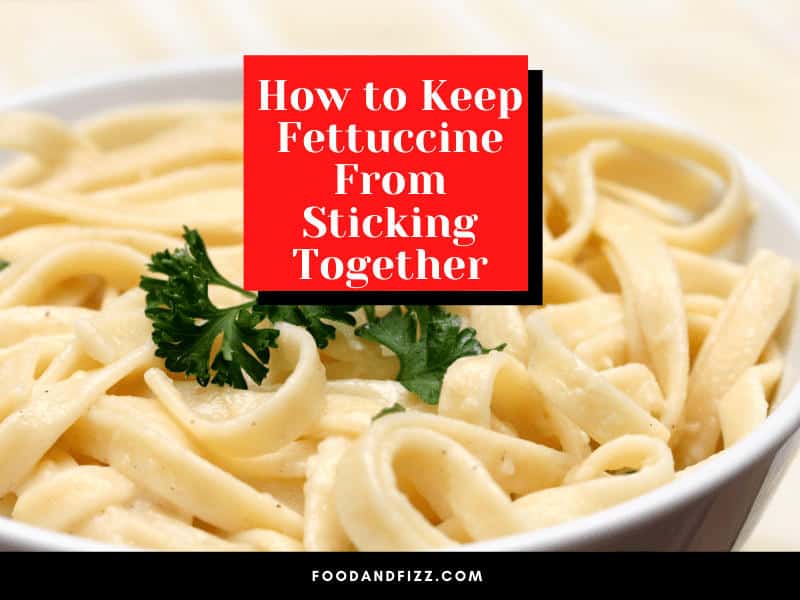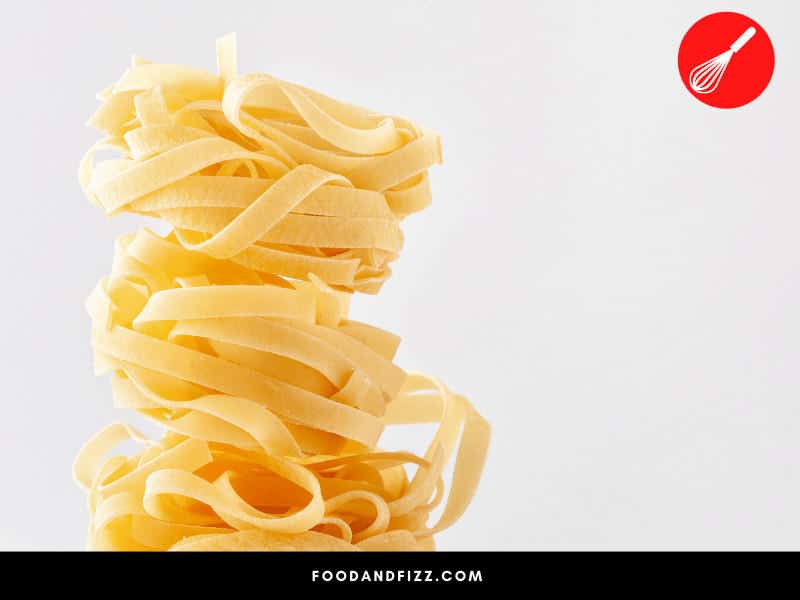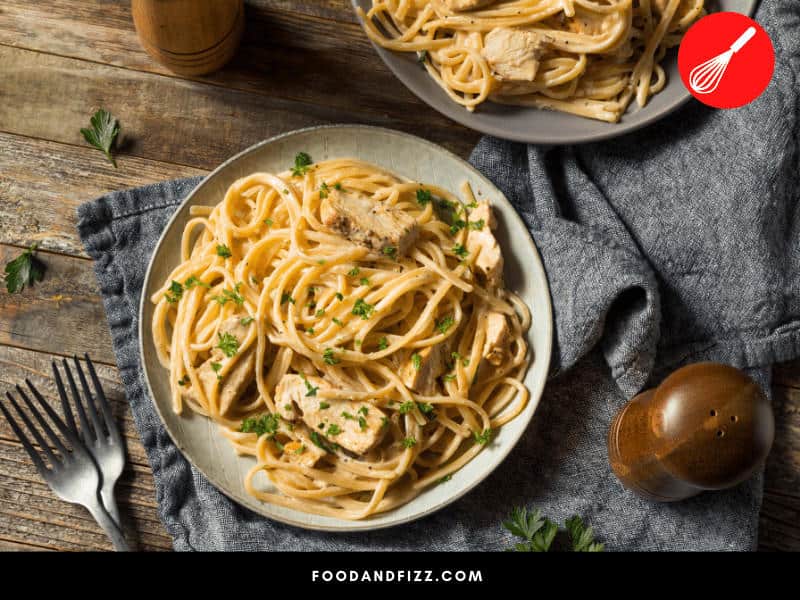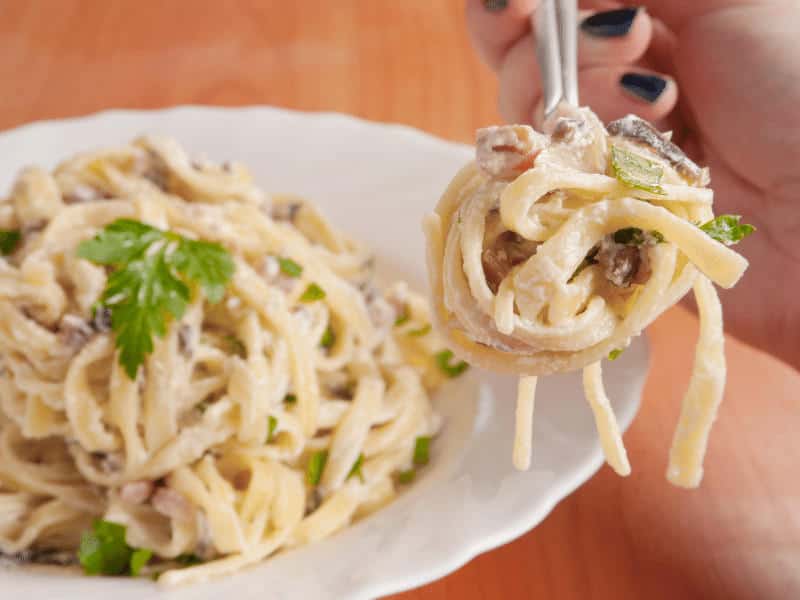How to Keep Fettuccine From Sticking Together? Fettucine is a long, flat pasta that’s often paired with creamy sauces. It usually takes between eight and thirteen minutes to cook and works well in a variety of dishes.
While this pasta is easy to prepare, you may find that your noodles stick together after they’re removed from the water. Thankfully, you can take a few precautions to make sure your fettuccine noodles don’t stick.
How to Keep Fettuccine From Sticking Together
To keep fettuccine noodles from sticking together constantly stir your pasta as it cooks. Once your fettuccine has finished cooking, you can keep it from clumping by rinsing the noodles with cold water. Coating fettuccine with oil can also help you keep your noodles separated.

Keeping Fettuccine from Sticking Together
While these quick tips can keep fettuccine from sticking, you should take a few more precautions to make sure your pasta is clump-free. Once you know how to cook fettuccine, you’ll be able to get the perfect al dente texture and keep all your noodles separated.

How to Keep Noodles from Sticking When You’re Preparing Fettuccine
Make sure you’re using a pot that’s large enough for your pasta. If you cram fettuccine noodles into a small pot, it’s more likely that some of your pasta will wind up stuck together.
In addition to using the right size of pot, you should make sure you’re using an appropriate amount of water. As a general rule, it’s best to use four quarts of water for every pound of fettuccine that you prepare.
Don’t add your pasta to the pot until the water has reached a full boil. If you add your fettuccine to the water too early, your pasta will release more starch, which will cause noodles to clump.
After you’ve tossed your fettuccine in the boiling water, you can lower the heat to medium-high. A slightly lower temperature will keep the pot from boiling over and will make it easier for you to stir the pasta as it cooks.
Speaking of stirring, you’ll want to continuously stir your fettuccine as it cooks. In fact, stirring is the most important step you can take to avoid clumping noodles.
If you toss your pasta in the pot and ignore it until it’s cooked through, the noodles will stay in one place. Not only will many of those noodles stick together, but some of your pasta may stick to the bottom of the pot as well.
Constant stirring will allow your fettuccine noodles to move, preventing them from sticking together. You may also want to use tongs to lift the noodles as they cook.
Once your noodles are drained, try to limit the amount of time they sit in the colander. Ideally, you should be adding your fettuccine to the sauce immediately after it’s been drained.

How to Keep Fettuccine from Sticking Once It’s Cooked
Even if you do everything right while your fettuccine is cooking, noodles could wind up sticking together after the pasta has been cooked. This is especially likely to happen if the drained pasta sits for a while before it’s served.
As mentioned above, you can rinse your pasta off with cold water to keep it from sticking. While this will cool off your pasta, it will also wash away the sticky starch that causes noodles to clump together.
Rinsing your noodles is also a way to prevent clumping when you’re storing pasta in the fridge. Once the starch has been rinsed away, the fettuccine noodles will stay separated, even if it sits for a long time.
If you’d prefer not to cool off your pasta, you can also try coating the fettuccine with something that will prevent it from sticking. Olive oil is a popular option, but you can also try adding butter to your noodles.
Just be aware that any substance you add could potentially impact the flavor of your pasta sauce. Think about what you want the dish to taste like before drizzling pasta with olive oil.
For dishes with a cream sauce, like Fettuccine Alfredo, coating noodles with butter is a solid option. However, you may want to omit some butter from the sauce to make up for the extra butter you’re adding to the pasta.
Oil is likely to be the best option for fettuccine dishes that use a tomato sauce. If you do add oil, make sure you don’t rinse off your pasta.
When you’re making a pasta dish with a vinaigrette sauce, it’s best to rinse your noodles. This is also your best choice if you’re preparing a dish that will be served cold.
If you do rinse your fettuccine noodles, you should be aware that this will cause them to stop cooking. Normally, pasta will continue to cook until it naturally cools.

Other Tips and Tricks for Cooking Perfect Pasta
While many people believe that adding salt to the water can keep pasta from sticking, that isn’t actually true. However, adding salt can add flavor to your pasta, giving you great taste with less salt.
Many people also recommend adding oil to pasta as it cooks to prevent sticking. It’s true that this can help prevent noodles from clumping together as they cook, but it can also create problems for you once your fettuccine is fully cooked.
If you add oil to your water, most of that oil will be drained away after you drain the pasta. On top of that, it can be harder to drain the pasta when the water is oily.
Instead, follow the recommendations above and add ingredients like oil and butter after the pasta has been drained. Take other precautions while your fettuccine is still cooking.
If you’ve made fettuccine from scratch, you should wait to cut the pasta until after it’s fully dry. You may also want to try sprinkling your freshly cooked noodles with a little bit of flour!
When you’re preparing packaged fettuccine, you should check the recommended cook time on the package, but you shouldn’t treat it as a firm rule. If you can tell that the pasta has softened, it’s best to drain it before more starch releases and the noodles have the chance to stick.
There are many pasta dishes that are easy to prepare, but even a simple dish can be ruined if the noodles clump together. Taking a few simple precautions will help you to make better dishes with less stress overall.

Frequently Asked Questions About How to Keep Fettuccine from Sticking Together
Should I Break Fettuccine Noodles Before I Cook Them?
Long pasta like fettuccine is designed to be wrapped around your fork. Because of this, it’s best not to break your pasta before it’s cooked.
Can I Substitute Fettuccine for Linguine?
You can use fettuccine as a substitute for any type of long pasta, and vice-versa. However, you should be aware that cook times can vary based on the type of pasta you’re cooking.
Conclusion On How to Keep Fettuccine from Sticking Together
It can be frustrating when the pasta you prepare clumps together. Thankfully, there are plenty of ways to keep your fettuccine from sticking together. With these steps, you’ll be able to make perfect fettuccine dishes every time you cook.

